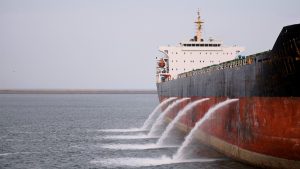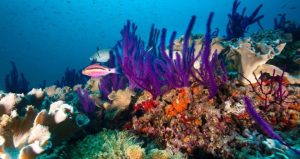Explore how ballast water from global shipping poses ecological threats in the Persian Gulf. Discover invasive species risks, scientific insights, and regional efforts to mitigate ballast water impacts.

Why Ballast Water and Invasive Species Matter in the Persian Gulf
The Persian Gulf may be one of the world’s most strategic waterways for oil and cargo, but it’s also one of the most vulnerable when it comes to marine ecological balance. While attention often focuses on oil spills and pollution, there’s another silent threat moving through its waters—invasive species transported via ballast water.
Ballast water is essential to modern shipping. Ships take on water to stabilize themselves when not fully loaded, and discharge it upon loading cargo—usually in a different port. In the process, they often release microscopic organisms, larvae, and bacteria that don’t belong in the new environment.
In semi-enclosed seas like the Persian Gulf—where shallow waters and slow exchange with open seas limit natural dilution—these organisms can thrive, disrupting native ecosystems, threatening fisheries, and even damaging port infrastructure. For maritime professionals, environmentalists, and regional policymakers, understanding the impact of ballast water is more than a regulatory concern—it’s a call to action.
–
Understanding Ballast Water and Invasive Species Transmission
How Ballast Water Works
When ships unload cargo, they compensate for the lost weight by pumping seawater into onboard ballast tanks. This helps maintain stability, trim, and structural integrity during transit. But with this water comes a biological payload: plankton, bacteria, fish eggs, and marine larvae from the source port.
When this ballast water is discharged in another port—often thousands of kilometers away—these non-native organisms are released into unfamiliar ecosystems where they may have no natural predators.
According to the International Maritime Organization (IMO), over 10 billion tons of ballast water are transferred globally each year, making it one of the largest vectors for marine biological invasions.
Why the Persian Gulf Is Especially Vulnerable
The Persian Gulf is:
-
Shallow (average depth ~35 m)
-
Warm year-round (25–35°C surface temperature)
-
Highly saline
-
Enclosed, with only the narrow Strait of Hormuz connecting it to open waters
These conditions can be ideal breeding grounds for hardy, opportunistic species. The Gulf’s ecosystems, already stressed by coastal development, pollution, and climate change, often struggle to resist foreign biological competition.
–
Invasive Species Detected in the Persian Gulf from Ballast Water
Several invasive species introduced through ballast water have already made a home in Gulf waters. These are a few of the most concerning:
Mnemiopsis leidyi (Comb Jelly)
Originally from the Atlantic coast of North America, this gelatinous predator has been found in Gulf waters since the early 2000s. It feeds on fish larvae and zooplankton, directly impacting local fisheries.
Research published in the Marine Pollution Bulletin (2022) found that Mnemiopsis populations correlate strongly with declines in anchovy and sardine stocks in Iranian and Kuwaiti waters.
Vibrio cholerae (Pathogenic Bacteria)
Several studies, including those conducted by the World Health Organization (WHO) and ROPME, have detected strains of Vibrio cholerae—a bacterium that causes cholera—in ballast water discharged near Gulf ports. This represents a direct public health risk, especially in densely populated port cities.
Mytilopsis sallei (Black Striped Mussel)
This invasive bivalve has been documented clinging to ship hulls and port structures in UAE and Oman. It rapidly colonizes artificial surfaces, clogging intake pipes and damaging desalination infrastructure—a serious concern in a region where over 60% of potable water comes from desalination.
20% of Persian Gulf’s aquatic species to be extinct in 80 years: expert. Credit: https://www.tehrantimes.com/news/443335/20-of-Persian-Gulf-s-aquatic-species-to-be-extinct-in-80-years
–
Case Studies: Ballast Water Impact in Real-World Context
The 2010 Al-Fujairah Port Biofouling Incident
In 2010, port authorities in Al-Fujairah (UAE) discovered dense growth of non-native barnacles and mussels near a cluster of recently arrived tankers. Subsequent investigation traced the source to ballast water released by bulk carriers originating from East Asia.
Kuwait Bay Zooplankton Shift
A multi-year survey published in Marine Ecology Progress Series showed a significant change in the composition of zooplankton in Kuwait Bay between 2015 and 2022. The arrival of Acartia tonsa, a copepod native to the Gulf of Mexico, was linked to increased ballast water discharge during post-pandemic shipping surges.
This shift disrupted food chains and affected commercially important fish populations like mullet and seabream.
–
Challenges in Managing Ballast Water in the Persian Gulf
Weak Enforcement of IMO’s Ballast Water Management Convention (BWMC)
Although the Ballast Water Management Convention (adopted by the IMO in 2004, enforced in 2017) has been ratified by most Gulf countries, actual enforcement varies.
According to Port State Control (PSC) reports from the Indian Ocean MoU and Riyadh MoU, inspections of ballast water treatment systems remain infrequent, and compliance documentation is often missing or outdated.
Limited Treatment Infrastructure at Ports
Unlike major global hubs like Singapore or Rotterdam, many Gulf ports lack shore-based treatment facilities. This places full responsibility on the vessel to carry and operate its onboard Ballast Water Treatment System (BWTS).
A 2023 study by DNV and Wärtsilä Voyage indicated that only 62% of Gulf-bound vessels had functional, certified BWTS equipment onboard, despite regulatory requirements.
High Costs and Technical Complexity
Installation and operation of BWTS can be expensive and technically complex. For regional short-haul operators, especially smaller vessels, these systems are seen as a regulatory burden, not a necessity—resulting in widespread non-compliance.
–
Solutions and Technologies: Turning the Tide on Invasive Species
Advanced Ballast Water Treatment Systems (BWTS)
Newer BWTS models use UV radiation, electro-chlorination, and filtration to eliminate invasive species before discharge. Leading manufacturers such as Alfa Laval, Ecochlor, and Wärtsilä offer IMO and US Coast Guard-approved systems now being installed in vessels transiting the Gulf.
Digital Monitoring Tools
Companies like Inmarsat and Thetius are collaborating on real-time compliance logging systems that help port authorities monitor ballast water records remotely, reducing inspection delays and enhancing transparency.
Regional Collaboration via ROPME
The Regional Organization for the Protection of the Marine Environment (ROPME) is working to align Gulf nations under a joint ballast water surveillance strategy, which includes:
-
Shared databases of invasive species sightings
-
Coordinated research programs
-
Unified legal frameworks for vessel compliance
This is supported by IMO’s GloBallast programme, which helps developing countries implement BWMC through training and capacity-building.
–
Future Outlook: Can the Persian Gulf Protect Its Biodiversity?
There is no quick fix—but progress is being made.
As maritime traffic through the Gulf continues to increase, so does the urgency to implement more consistent and science-backed ballast water management. With IMO deadlines pushing for universal BWTS installation by 2026, and regional authorities becoming more aware of the ecological stakes, the groundwork for a unified Gulf response is slowly emerging.
Promising signs include:
-
Qatar and UAE upgrading their port inspection systems
-
Saudi Arabia investing in shore-based treatment prototypes
-
Iran initiating ballast discharge studies in Bushehr and Bandar Abbas
Still, enforcement, public awareness, and technological uptake must scale up dramatically if native Gulf ecosystems are to be preserved in the face of rising biological introductions.
–
Frequently Asked Questions (FAQ)
What is ballast water and why is it important in shipping?
Ballast water stabilizes vessels during transit. But when discharged, it can release non-native marine organisms into new environments, often disrupting local ecosystems.
How do invasive species enter the Persian Gulf?
Mostly through ballast water discharge by ships traveling from other regions. Organisms in the water survive the voyage and establish themselves in Gulf ecosystems.
Which invasive species are a threat in the Persian Gulf?
Examples include the comb jelly Mnemiopsis leidyi, Vibrio cholerae bacteria, and black-striped mussels, all introduced through ballast water.
What international law governs ballast water discharge?
The IMO’s Ballast Water Management Convention (BWMC), enforced since 2017, regulates how ships must manage and treat ballast water.
Are Gulf countries complying with ballast water rules?
Most have ratified the BWMC, but actual enforcement and treatment facility availability vary widely.
What technologies are being used to treat ballast water?
UV disinfection, electro-chlorination, and filtration systems are common. Many are installed onboard, while some ports are developing shore-based alternatives.
Can ballast water spread human diseases?
Yes. Pathogens like Vibrio cholerae have been found in ballast water and can pose serious health risks.
–
Conclusion: Protecting Gulf Waters, One Tank at a Time
Ballast water is both a lifeline and a liability for global shipping. In the Persian Gulf, where ecosystems are already stretched thin, invasive species brought in through ballast discharges can be devastating.
But the story is not all doom and gloom. With proper enforcement of the Ballast Water Management Convention, smarter technology, and regional cooperation, the tide can turn. The Persian Gulf has a chance not only to protect its unique marine life—but to become a model of responsible shipping practices in ecologically sensitive waters.
For maritime professionals, students, and policy stakeholders, one thing is clear: clean ballast water equals a cleaner, safer future for all.
References
-
International Maritime Organization (IMO). (2023). Ballast Water Management Convention (BWMC). Link
-
Marine Pollution Bulletin. (2022). Biological Invasions via Ballast Water in the Persian Gulf.
-
Regional Organization for the Protection of the Marine Environment (ROPME). (2023). Invasive Species Risk Assessment Report. Link
-
DNV Maritime. (2023). BWTS Compliance in the Gulf Region. Link
-
Wärtsilä Voyage. (2023). Smart BWTS Systems for Global Vessels. Link
-
Inmarsat Maritime. (2023). Digital Monitoring of Environmental Ship Operations. Link
-
Thetius. (2023). Ballast Water Compliance Software Innovations. Link
-
WHO. (2021). Cholera Risk from Maritime Transport. Link
-
Marine Ecology Progress Series. (2022). Zooplankton Changes in Kuwait Bay.
-
Paris MoU and Indian Ocean MoU. (2023). Port State Control Annual Reports. Link


